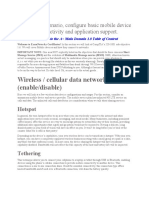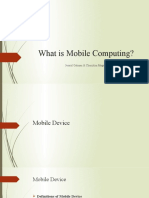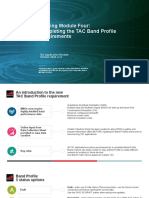Networking
Wireless Networks
Mobile phones use radio waves to transmit voice signals to antennas mounted on
towers located in specific geographic areas. When a telephone call is made, the
voice signal is relayed from one tower to another tower until it is delivered to its
destination. This type of network is used when you make a phone call to another
mobile phone or to a wired telephone. It is also used to send text messages
directly from the phone. The most common type of cellular telephone network is
called a GSM network. The abbreviations 3G, 4G, 4G-LTE, and 5G are used to
describe enhanced cell phone networks that are optimized for the fast
transmission of data. Currently, 4G still dominates as the current mobile network
used by most phones.
In addition to the GSM and 4G/5G transmitters and receivers, smartphones make
connections in a variety of ways.
Wi-Fi transmitters and receivers located within the smartphone enable the phone
to connect to local networks and the internet. Wi-Fi networks are usually
privately owned but often provide guest or public access hotspots. A hotspot is
an area where Wi-Fi signals are available.
Bluetooth is wireless technology that allows devices to communicate over short
distances. Multiple devices can be connected at the same time with Bluetooth.
NFC is a wireless communication technology that enables data to be exchanged
by devices that are in very close proximity to each other, usually less than a few
centimeters.
expand_less
Mobile Device Connectivity
Almost all mobile devices are capable of connecting to Wi-Fi networks. These
precautions should be taken to protect Wi-Fi communications on mobile devices:
Never send login or password information using unencrypted text
(plaintext).
Use a VPN connection when possible if you are sending sensitive data.
Enable security on home networks.
Use WPA2 or higher encryption for security.
Two of the most popular operating systems for mobile devices are Android and
Apple iOS. Mobile devices are preprogrammed to use a Wi-Fi network for the
internet if one is available, and the device can connect to the access point and
receive an IP address. If no Wi-Fi network is available, the device uses the cellular
data capability if it is configured.
Bluetooth technology provides a simple way for mobile devices to connect to
each other and to wireless accessories. Bluetooth is wireless, automatic, and
uses very little power, which helps conserve battery life. Some examples of
�devices that use Bluetooth include hands-free headsets, keyboards, a mouse,
stereo controls, car speakerphones, and mobile speakers.
Bluetooth pairing occurs when two Bluetooth devices establish a connection to
share resources. In order for the devices to pair, the Bluetooth radios are turned
on, and one device begins searching for other devices. Other devices must be
set to discoverable mode, also called visible, so that they can be detected.
When a Bluetooth device is in discoverable mode, it transmits the following
information when another Bluetooth device requests it:
Name
Bluetooth class
Services that the device can use
Technical information, such as the features or the Bluetooth specification
that it supports
During the pairing process, a PIN may be requested to authenticate the pairing
process.




















































































